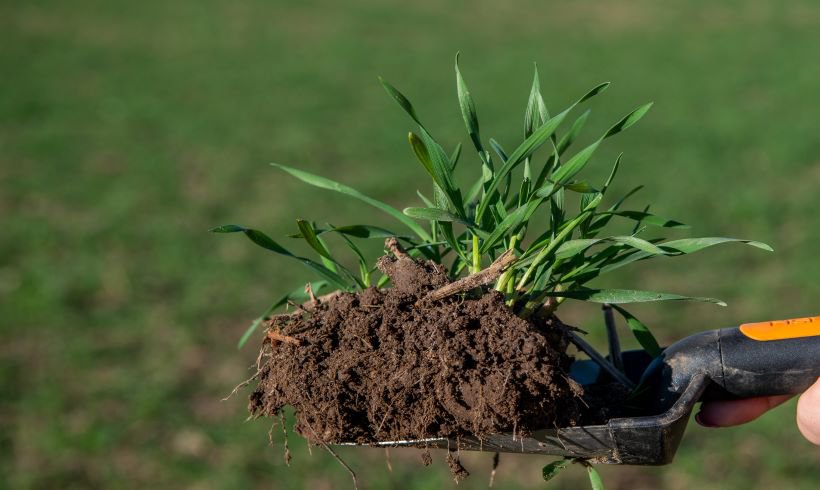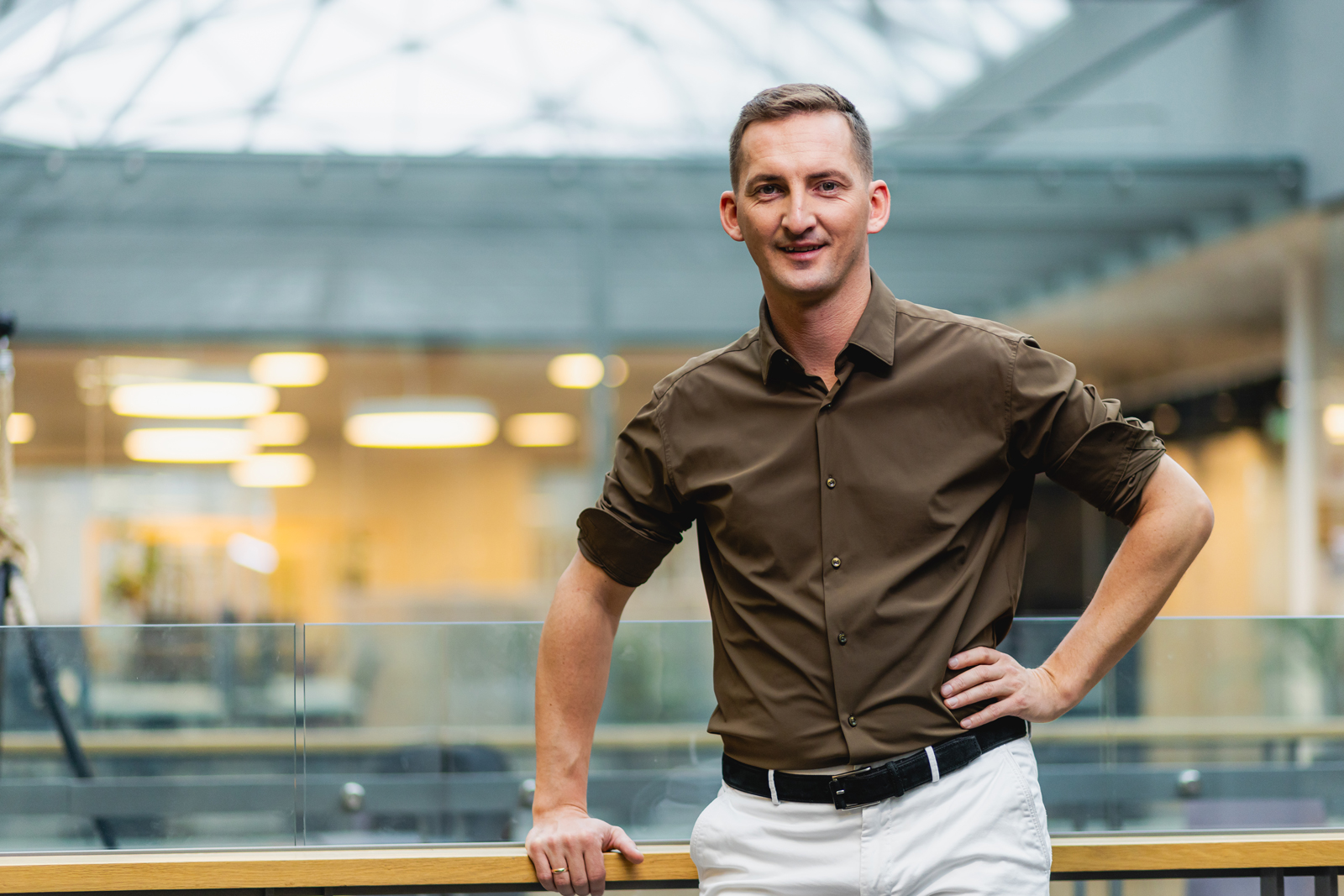Farmers don’t need to be told about climate change because they feel its effects every year. How can we not only avoid financial losses, but also make a profit while contributing to the EU’s ambitious climate and biodiversity targets? For years, there have been calls for a shift towards sustainable farming. So if you’re still thinking about giving it a try, or if you’re lacking information on what carbon certificates are and why it pays to practice sustainable agriculture, then this interview is for you. We’ll discuss the most pressing issues with Laimonas Noreika, Director of HeavyFinance, one of the first companies in Europe to be accredited to generate carbon emission certificates (photo).

© Egidijus Vilkevičius photo, agroakademija.lt
Carbon farming is identified as a sustainable farming trend. What is it? What are the important steps in farming?
Farmers are businesses, so naturally they have to think about profit. Carbon farming is a secondary, but very positive, way of farming the right way – restoring and preserving the land. Let’s briefly recall photosynthesis: the plant feeds on CO2, uses some of the organic carbon as building material and releases the rest through the roots, where it feeds a variety of bacteria and fungi in exchange for the missing nutrients, the biomass of which is then converted into stable organic carbon in the soil. Any intensification of tillage has a negative impact on the fungal network. Ploughing greatly intensifies biological processes and the organic carbon, which is important for plants, reacts with oxygen and is released as CO2. It is CO2 emissions that cause climate change.
Global business and government institutions agree to pay for the removal of carbon dioxide from the atmosphere in any number of ways. Farming is one way, reforestation is another, and it is even possible to concrete over the organic carbon and dump the lump into the ocean.
The first step towards sustainable farming is minimum tillage. At least half of Lithuanian farmers have taken this step by adopting no-till farming. Most of the organic carbon comes from the amount that is left on the soil, so it is important not to “uproot” it, but to allow it to continue to accumulate in the soil. What the farmer does with the straw after harvesting is important: whether or not he leaves it on the field to rot organically. The second step is the cultivation of catch crops. The third step is crop rotation, the fourth is fuel reduction and the fifth is fertiliser reduction.
We cannot say how far farmers are getting it right. We believe that farmers still need a lot of knowledge and good practices. Our aim is to talk to farmers who have started this journey or are about to embark on it, to continue to share the knowledge of international agronomists with them and, of course, to reward them for this.
You are one of the first companies and agricultural finance platforms in Europe to launch a sustainable agriculture programme to reduce the CO2 footprint. You have set a target of eliminating 1 gigatonne of CO2 emissions by 2050. How are you doing?
We’re on the move. Together with our Lithuanian and Polish farmers, we estimate that we are already storing organic carbon on hundreds of thousands of hectares. We teach them how to lock up the organic carbon and reward them for their work. By the way, for participating farmers who want to make the switch, or who want to do more but need financial support, we offer interest-free loans to help them make the transition to sustainable farming as quickly as possible.
We only started this programme last year and have already lent €5 million to farmers. The journey just started, and we have set ourselves a distant but ambitious goal. I believe that agriculture can do a lot. If we think of it as an industry, then, by cultivating such a large amount of fields properly, instead of being a polluter, it is possible to become a CO2 emitter.
We want to accelerate this transition, which is why we have set ourselves this target and are working effectively towards it. 1 gigatonne of CO2 emissions is small. That is how much Japan emits per year. We estimate that 400 000 tonnes of CO2 are absorbed by our farmers in the soil every year. That is a lot for one company, but it is only a small step for the whole of humanity. The road is long, the goal is ambitious and much needed. It would be great if there were more organisations like “HeavyFinance”.
What are the long-term benefits of carbon farming?
The potential is huge. If we could make this industry, the third most polluting, at least climate-neutral, that would be a huge change. If we can encourage more sustainable farming, this is possible. Moreover, without even thinking about the climate, this way of farming revitalises the soil year after year, making it stronger, more productive, more resilient to droughts and heavy rains. Organic carbon locked in the soil essentially creates more black soil, which means more production, less fertiliser, etc., making farming a more profitable business. Just wins.
Let’s be more specific about the numbers. How many tonnes of organic carbon can a hectare of cultivated land in Lithuania roughly store, and how much could a farmer earn from carbon certificates?
One hectare can “bury” around 0.5-0.6 tonnes of organic carbon per year. But if we translate this into CO2, we need to multiply by 3.9, i.e. 1 t of organic carbon is 3.9 t of CO2. Thus, about 2.3 t of CO2 can be accumulated per year. The more larger the problem becomes worldwide, the more organisations will be prepared to pay to remove 1 t of CO2 from the atmosphere. Today, for 1 tonne of CO2 removed from the atmosphere by sustainable agricultural practices, the price can be around €35.
We visited a number of farmers’ fields, taking soil samples and monitoring changes in organic carbon. We found that, on average, a hectare of land in Lithuania absorbs about 2.3 tonnes of CO2 per year when properly cultivated. If we translate this into money, we would get about €80/ha in income. Excluding the cost of CO2 extraction-sale, at the current price, a farm can confidently expect to receive €50/ha/year. I believe that this would make a significant contribution to increasing farm profitability.
Tell us more about carbon credits (certificates) and their market. How are they sold? What are the forecasts?
There are various ways to pay for the separation and burial of organic carbon. There are public programmes, mandatory programmes, etc. Today, carbon credits to the farmer are paid for by the so-called optional good works market.
For example, a bank decides to become climate neutral. First, it takes action itself, e.g. using less paper, driving less, flying less, changing servers, using renewable energy, etc. But even if a bank carefully reduces its carbon footprint, it cannot become climate neutral, because its staff still travel to work, the office uses electricity, etc. To compensate for this damage, the bank buys emissions certificates from people who have done a good job somewhere, i.e. removed CO2 from the atmosphere. So farmers in Lithuania can be paid by a company in America, for example, for doing a good job.
How does it work?
It is really difficult for a farmer to both create and prove credit and sell it directly, even to large agricultural corporations. This role is played by organisations such as “HeavyFinance”. We prove, we certify, we get the credits, we find a buyer who buys them.
The carbon credit market depends on supply and demand from buyers. Which will grow faster? It is hard to say. Either farmers will move more quickly and start locking up more organic carbon, or there will be more buyers willing to purchase carbon credits.
If a farmer has already taken many steps – sustainable farming practices such as crop rotation, intercropping, minimum tillage, etc. – but is not involved in carbon storage. How can he join a carbon farming programme?
The farmer first needs to contact a company that has a carbon farming programme. Then various support mechanisms kick in: conversations with agronomists, talking about how the fields are farmed and how they could be improved. Farmers decide whether the commercial terms are right and which organisation they trust, and then start that journey. It is not a short journey, about two years before the first carbon credits, provided, of course, that the farming is done right. But it is not a complicated process.
The transition from conventional to carbon farming imposes additional costs on farmers, which is why not only emission reductions are important, but also financial compensation. What is the best mechanism here?
If a farmer is just on the threshold of sustainable farming, using a plough will not do it in one year. The first step is to buy other implements. They are expensive. Then you need a more powerful tractor, etc. Our company estimates that it would cost EUR 100-150 000 just to buy the right equipment. In this case, farmers need help.
We see that both Europe and the State are beginning to understand the importance of carbon storage in farming and are therefore starting to target their support. I am talking about a development loan for the purchase of implements for sustainable farming. And as a company, we have developed a special product – we lend free of charge for this transition. The first step is very important.
Then comes the long journey: how to wean the soil off excess fertiliser, how to replace it with organic fertiliser, how and which intercrops to use, how to reduce fuel consumption, etc. But the journey is well worth it, and our team of agronomists and soil scientists are always ready to help.
They say there’s no better time than now. What would you wish for farmers?
Farmers have no other choice. We need to understand and learn how to farm sustainably, because the world is facing an existential problem and will address it in different ways. Now there is a gingerbread proposal: farmers are encouraged to move towards sustainable farming. For those who do not, there will be the whip principle. I suggest that we all think about the gingerbread. And if you are interested in sustainable farming, please contact us.
You can also read about sustainable farms stories sharing their experiences and the benefits of the programme. You will find them in the news section.
Thank you for the conversation.
Written by: agroakademija.lt editor-in-chief Ramunė Sutkevičienė

